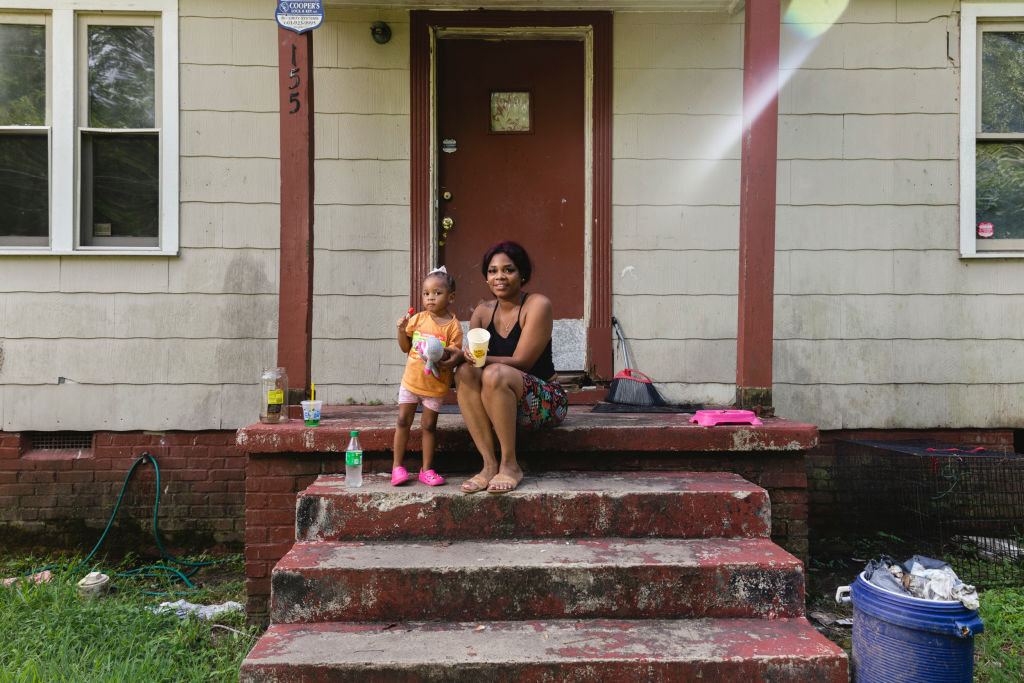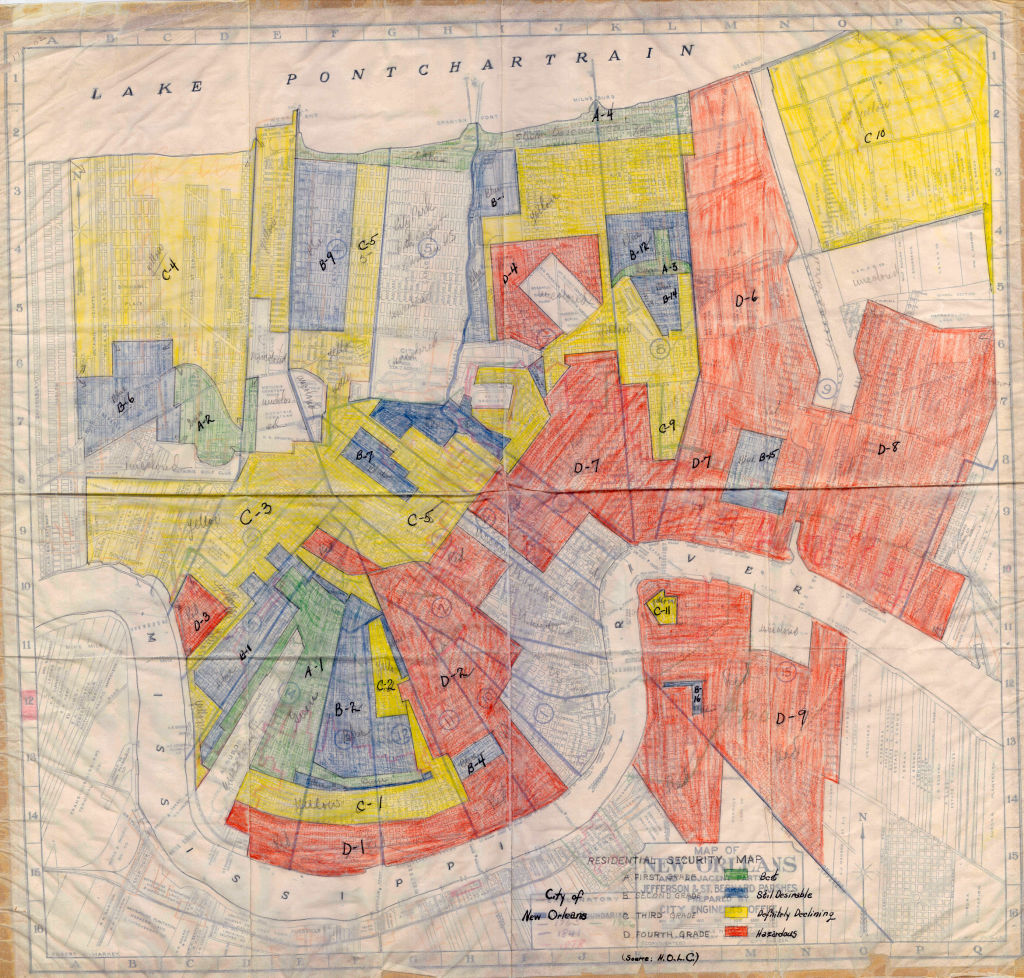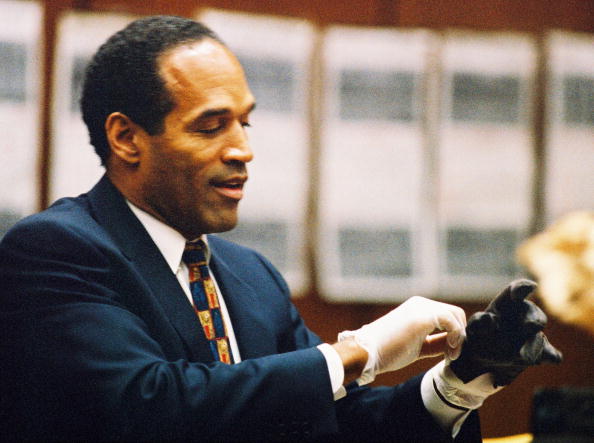
Roshonda Snell and her 2 years old daughter sit on their stoop in the house they have been renting for the past 3 years in South Jackson on September 1st, 2022. Their water pressure is lower than usual and the water has a brownish color. They often stock up on cases of water bottles in case there are new problems with the city water. Their water bill is sometimes up to $1000, and there is a leak in the pipe in their front yard that no one has come to fix. (Photo by Camille Lenain for The Washington Post via Getty Images)
UPDATED: 5:00 p.m. ET, Sept. 16
Environmental racism is once again a topic of discussion as the water crisis in Jackson, Mississippi has left everyone wondering how things could have gotten so bad.
According to AP, Gov. Tate Reeves’ lifted the city’s months-long boil-water advisory on Thursday announcing that the water was clean. He also said that the state plans to stop giving free bottled water on Saturday. But city officials and residents say the problem is nowhere near resolved and that water remains too discolored to count on. Jackson’s water problems have persisted for decades.
Jackson has struggled with safe water access since the 1940s. In the 1970s and again in 2020, the EPA warned that the city had to get serious about updating its infrastructure to improve water quality.
Many residents and politicians say that racism is the reason for Jackson’s water woes.
“The legacy of racial zoning, segregation, legalized redlining have ultimately led to the isolation, separation and sequestration of racial minorities into communities (with) diminished tax bases, which has had consequences for the built environment, including infrastructure,” said Marccus Hendricks, an associate professor of urban studies and planning at the University of Maryland, told AP.
Jackson has a population of over 149,000 and nearly 85.5 percent of residents are Black, according to The Census.
Racism isn’t always seen or heard. Sometimes it’s hidden inside the systems that make America function. But you don’t need to see it for its impact to be disastrous to Black Americans.
When most people think of an environmental crisis they think of climate change, which is understandable since it’s arguably the biggest issue young people face today. But what is always left out of the conversation is the fact that climate change disproportionately affects people of color and it’s not an accident, it’s environmental racism.
Environmental racism is defined as environmental injustice that occurs within a racialized context both in practice and policy.
The concept describes the disproportionate impact of environmental hazards on people of color. Higher air pollution and rising temperatures have always plagued communities of color, but so have a host of other issues.
It’s kinda hard to talk about air pollution being the biggest issue Black communities face when Ahmaud Arbery can’t even go for a jog without losing his life. But the conversation is important because so many Black Americans are affected.
To understand environmental racism and its impact let’s first dive into its history.
The History Of Environmental Racism
The term was coined by civil rights leader Benjamin Chavis in 1982. The environmental justice movement began during the Civil Rights Movement in the 1970s. But, environmental oppression dates back to America’s racist redlining practices in the 1930s. The Great Depression lead to historic housing practices which allowed banks and insurance companies to color-code residential maps of US cities, distinguishing neighborhoods largely based on race. Black neighborhoods were color-coded ‘red’ and deemed hazardous or low value. This also allowed banks to control where Black families lived in cities throughout the country by only allowing them mortgages in ‘redlined’ areas, many of which are still predominately Black.
A recent study found that neighborhoods formerly redlined back in the 1930s experience higher temperatures today as compared to the neighborhoods not redlined, in some places almost 13 degrees hotter.

Redline Map for New Orleans, Louisiana, 1935. – Source: HUM Images / Getty
The study also found that families living in these neighborhoods received reduced access to credit and limited real estate investment over time, leading to increased segregation and lower homeownership.
Environmental racism is commonly misinterpreted as a problem that only plagues poor folks, but its effects on middle-class Black Americans have been devastating. Landfills, power plants, and waste management facilities commonly find their way into the majority of middle-class Black neighbors.
During a 2007 study, sociologist Robert Bullard found that race was a more accurate indicator of proximity to pollution than socioeconomic status. Bullard’s shocking revelation suggested that race was more important than income when predicting the location of the nation’s commercial hazardous waste facilities. He proved that Black Americans making $50-60,000 a year are more likely to live in a polluted neighborhood than their white counterparts making $10,000.
There are so many modern-day examples of environmental racism. One that stands out the most from recent history is the water crisis in Flint, Michigan.
In 2014 the predominately Black city changed its water source to the Flint River without properly treating the water supply. Over 100,000 people, including children, were exposed to lead-contaminated water, even E.coli. Years later the water problem still hasn’t been completely solved in Flint.
Chicago also has had a recent battle over environmental racism. The city recently denied a permit application for General Iron to move its operations to the city’s Southeast Side, which is majority Black and Latino.
According to a recent report, Black and Latino residents in Chicago are more likely to have chronic health conditions due to living close to industrial pollution.
Environmental Racism Solutions
Many of these cities are not given the proper resources to win the battle against climate change. As serve heat waves, floods and hurricanes worsen, so will the importance of understanding environmental racism. The more we know, the more we can demand the resources we need to solve problems and save lives. Although the plight of environmental racism is daunting, there is hope.
The environmental justice movement and the people who support it hope to be the catalyst for change.
Grassroots organizations that promote environmental justice look to educate communities on the dangers of environmental racism, but it won’t be enough without your help. Pay close attention to your local Government and policies. If a landfill or waste company wants to put a facility in your area, they have to go through the city first. Don’t be afraid to put pressure on your elected officials if you oppose practices or policies that could be harmful to your community. The power of boycott can change the tides
SEE ALSO:
What Is Redlining And How Can It Be Solved?
40 Acres And A Mule: What Are Reparations And Why Is The Concept So Polarizing?

















